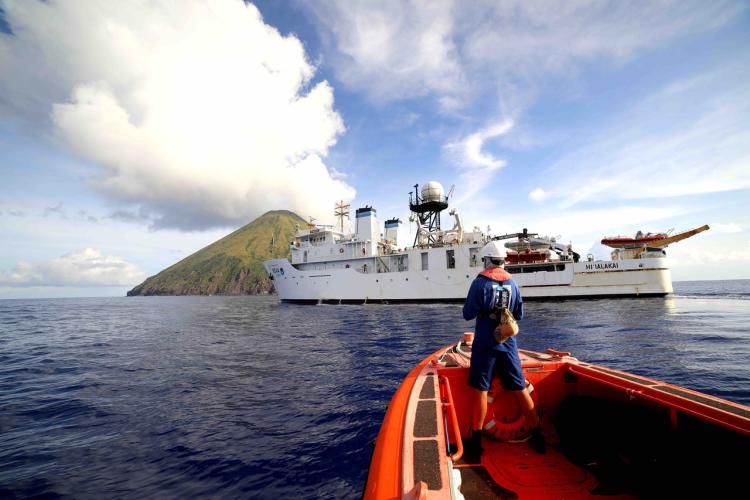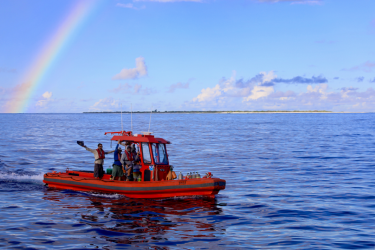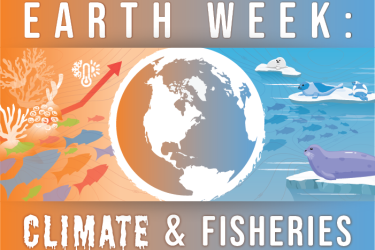NOAA Fisheries research surveys provide data critical to the stewardship of our nation's ocean resources and their habitat. For 150 years, our scientists and partners have collected survey data to understand current and changing ocean conditions and monitor marine life. The insights we gain are the heart of our vital services to strengthen the blue economy (PDF, 18 pages), maintain productive and sustainable fisheries, conserve protected resources, and support healthy ecosystems.
What We Do
Our scientists and partners conduct surveys from shore, aboard NOAA ships and chartered fishing vessels, on planes, and using autonomous vehicles. They collect data with fishing gear, scuba equipment, satellite tags, cameras, human observers, acoustic equipment, and instruments that measure ocean conditions.
What we collect during a research survey—and how frequently—depends on what we are observing. Some surveys target specific species or stocks, while others take a broad sample of species and conditions in an area.
We conduct each survey on a consistent schedule. Some happen multiple times a year. Others are conducted up to every 3 years. For all of our surveys, scientists sample within consistent areas and use standard protocols. This allows us to follow trends throughout the U.S. exclusive economic zone.
The data we collect during a research survey can provide information on the following:
- Species numbers and distribution
- Reproduction and growth rates
- Population behaviors and distributions
- Contaminants in animal tissues
- Environmental data like water temperature, dissolved oxygen levels, and chemical measurements tied to ocean acidification
Next Generation Technologies
We continuously build on the foundation of our research surveys and long-term data sets. New technologies and techniques improve the precision and accuracy of our data. They also allow us to expand our survey areas and collect data more frequently.
Our scientists calibrate the new technologies and techniques with existing data. This helps ensure the data is accurate and can be compared from year to year.
Critical Partnerships
Strong partnerships are essential to the success of our research surveys. Our partners include:
- Other federal and state agencies
- Universities
- Fishing industry
- Foreign governments
- Instrument and survey platform developers
NOAA Fisheries coordinates a national cooperative research program to partner with fishing groups, universities, and other stakeholders to design and implement surveys.
Public-private partnership key to annual bottomfish survey in Hawaiʻi
Additional management and science partners
Where Data Is Used
Research surveys are one of our primary sources of data. This information is used with commercial, recreational, and subsistence fishing data in a range of assessments and models:
- Fishery and protected species population assessments
- Ecosystem modeling
- Integrated ecosystem assessments
- Additional scientific research
These allow us to build a holistic picture of complex interactions between marine life, their environment, and human activities. That picture helps us make sound decisions for managing fisheries, protecting marine mammals, recovering endangered or threatened species, and conserving habitats.
Benefits of Research Surveys
We rely on surveys to maintain the health of sustainable fisheries, protected resources, and their habitats. Robust and long-term survey data allows us to detect and forecast trends in these resources.
Healthy marine resources are critical to the U.S. economy, recreation, food security, and the socioeconomic health of coastal communities. Research surveys make these benefits possible. They support:
- 1.2 million jobs from fishing and seafood activity in 2019
- $79 billion added to the gross domestic product in 2019
- Robust tourism and recreation industries
- Sustainable management in more than 4 million square miles of federal water
- Access to sustainable, healthy seafood
Fisheries Economics of the United States report
The economic importance of seafood
Social indicators for coastal communities
Responding to Change
As stewards of marine life and their habitats, we have to adapt our management to changing conditions. We rely on existing and expanded survey results to do that.
Marine environments are incredibly complex and constantly changing. Scientists expect new and more intense environmental changes as a result of shifts in the planet’s climate systems. New and growing marine industries, such as offshore wind energy, can also impact ecosystems.
Our surveys update information on fish stock dynamics, ecosystem health, and the status of endangered species and other protected resources. Many of our surveys also collect measurements that help us study the link between climate change and ocean ecosystems. For example, ocean temperature, chemistry connected to ocean acidification, salinity, and ocean currents.
Climate vulnerability assessment
Climate science strategy regional climate action plans
Science Center Activities
Research surveys are conducted by our regional fisheries science centers and tracked nationally through the Fisheries-Independent Survey System. This system provides information on the number and types of surveys planned for each year. It also includes regular status updates.
Alaska
The Alaska Fisheries Science Center conducts surveys to collect data and information needed to safeguard the valuable U.S. Arctic and sub-Arctic. These areas supply around 60 percent of the seafood harvested in the United States and support a nearly $2 billion ecotourism industry. They are also warming faster than anywhere else on the planet. This is leading to record heat waves, rapidly declining and changing sea ice, melting glaciers, and dramatic shifts in marine ecosystems.
Robust research surveys are vital to maintaining the health of Alaska’s fisheries, protected resources, and habitats in the face of change. Survey findings also support our co-management agreements with Alaska Native communities to preserve their rich cultural heritage and food security.
Fish research surveys in Alaska
Marine mammal field work in Alaska
Podcast: Surveying Alaska's Waters
Northeast
Timing and consistency are especially critical to our surveys in the Northeast U.S. Shelf Regional Ecosystem, where there are large seasonal cycles in temperature. The Northeast Fisheries Science Center conducts more than 20 surveys independently and with regional partners. They monitor the health and abundance of marine life and habitats in response to a changing climate and expanding ocean uses.
Our Northeast surveys support sustainable commercial and recreational fisheries that contribute approximately $8 billion to the regional gross domestic product. The data we collect also helps coastal communities adapt to climate change and other effects of a changing ocean environment.
Podcast: Evolving Science and Surveys in the Birthplace of NOAA Fisheries
Northwest
The Northwest Fisheries Science Center’s surveys focus on West Coast groundfish and Pacific salmon populations. We use the biological and environmental data collected to:
- Sustainably manage commercial and recreational fisheries
- Protect salmon and killer whales under the Endangered Species Act
- Understand broader environmental trends
Surveys also help us understand and respond to the socio-economic impacts from a changing ocean in the Northwest. Marine fisheries, tourism, and related industries are critical to communities and economies in Washington and Oregon. Recreational fishing and the seafood industry on the West Coast alone account for nearly 70,000 jobs and generate almost $7 billion in sales.
Research surveys in the Pacific Northwest
The Newportal survey blog series
Podcast: Collecting Data on Diverse West Coast Waters
Pacific Islands
The Pacific Islands are surrounded by a rich diversity of marine life that is vital to the culture and economic stability of the islands and the overall health of the Pacific Ocean. The region is home to coral reefs that support 25 percent of fish in the Pacific Ocean and as many as 2 million marine species.
The Pacific Island Fisheries Science Center conducts surveys with regional partners. They assess the health of these valuable marine resources and understand how they are affected by a changing climate. The data is used to set annual catch limits for fish stocks, recover protected species, and conserve marine habitats.
Research surveys in the Pacific Islands
Podcast: A Look at the Vast Waters and Rich Diversity of Marine Life in the U.S. Pacific Islands
Southeast
The Southeast Fisheries Science Center conducts surveys in the U.S. Gulf of Mexico, Caribbean Sea, and along the southeastern seaboard. The data from these surveys is vital to the sustainability of the region’s recreational fisheries, which attract anglers across the country and support hundreds of thousands of regional jobs. Survey data is also used to manage economically and ecologically important commercial fisheries and to protect endangered species like sperm whales, Rice’s whales, and leatherback sea turtles.
Researchers in the Southeast rely on the long history of survey data to understand the impacts of a changing climate on regional environments, ecosystems, and communities.
Southeast science surveys and research
Marine mammal research surveys in the Southeast
Podcast: Surveying the Southeast
Southwest
Southwest Fisheries Science Center surveys gather biological and environmental data in the diverse and dynamic California Current Ecosystem, which spans the entire U.S. West Coast. We use advanced sampling techniques and leverage industry partnerships to maintain long-term data sets. These data sets are critical to understanding the ecological and socio-economic impacts of a changing ocean in this area. The California Current ecosystem supports valuable fisheries, recreation, tourism, energy production, and other ocean economic activities worth more than $56 billion. In California alone, fishing and related industries support around 30,000 jobs and generate more than $3 billion in overall sales.
Researchers in the Southwest also conduct surveys of Antarctic krill and the krill-centric ecosystem in the Southern Ocean. Data collected informs the U.S. delegation to the Commission for the Conservation of Antarctic Living Marine Resources. The Commission considers the needs of krill-dependent predators when setting harvest rules for the fishery.
Autonomous Gliders in Antarctica blog series
California Cooperative Oceanic Fisheries Investigations








